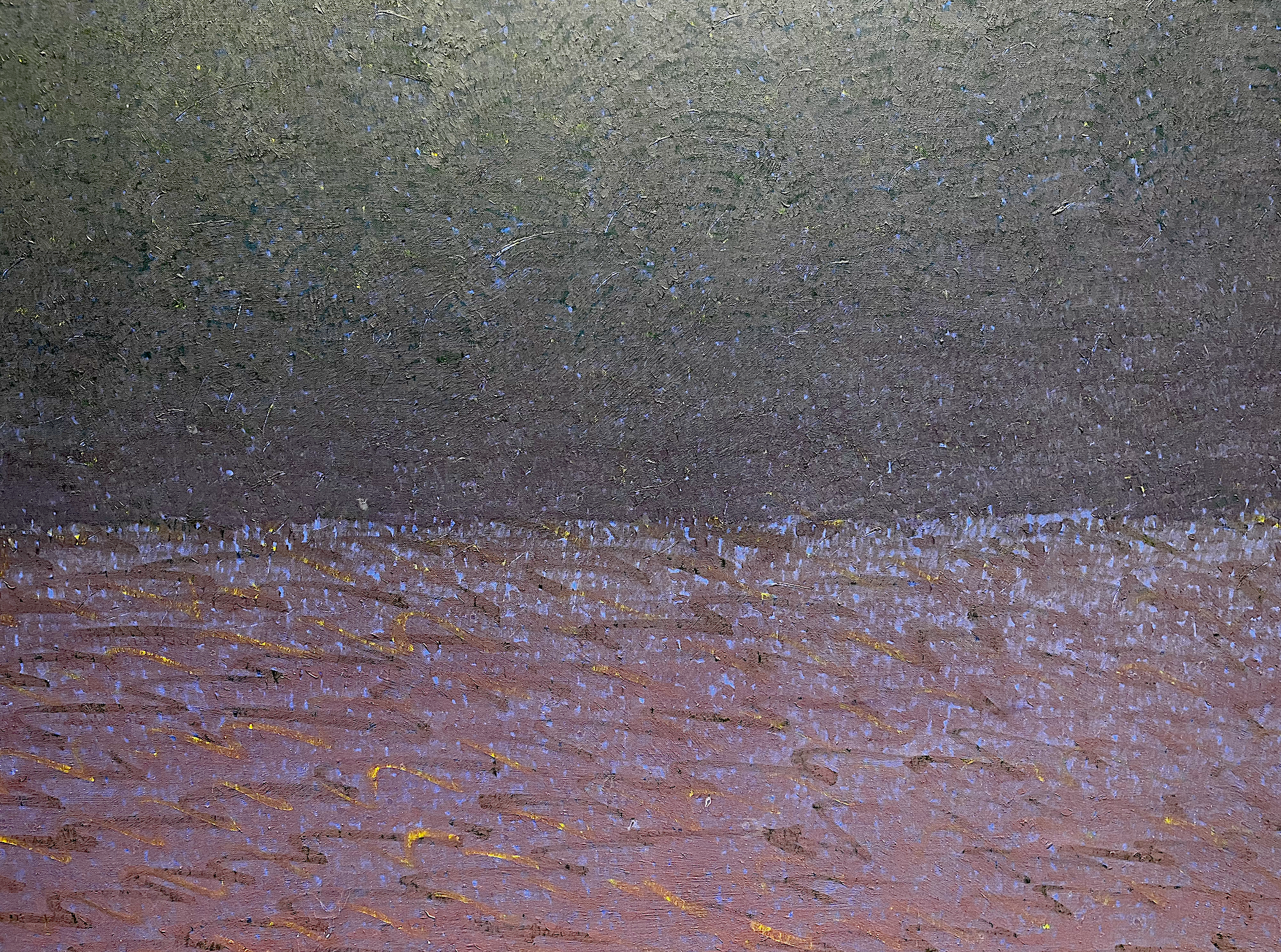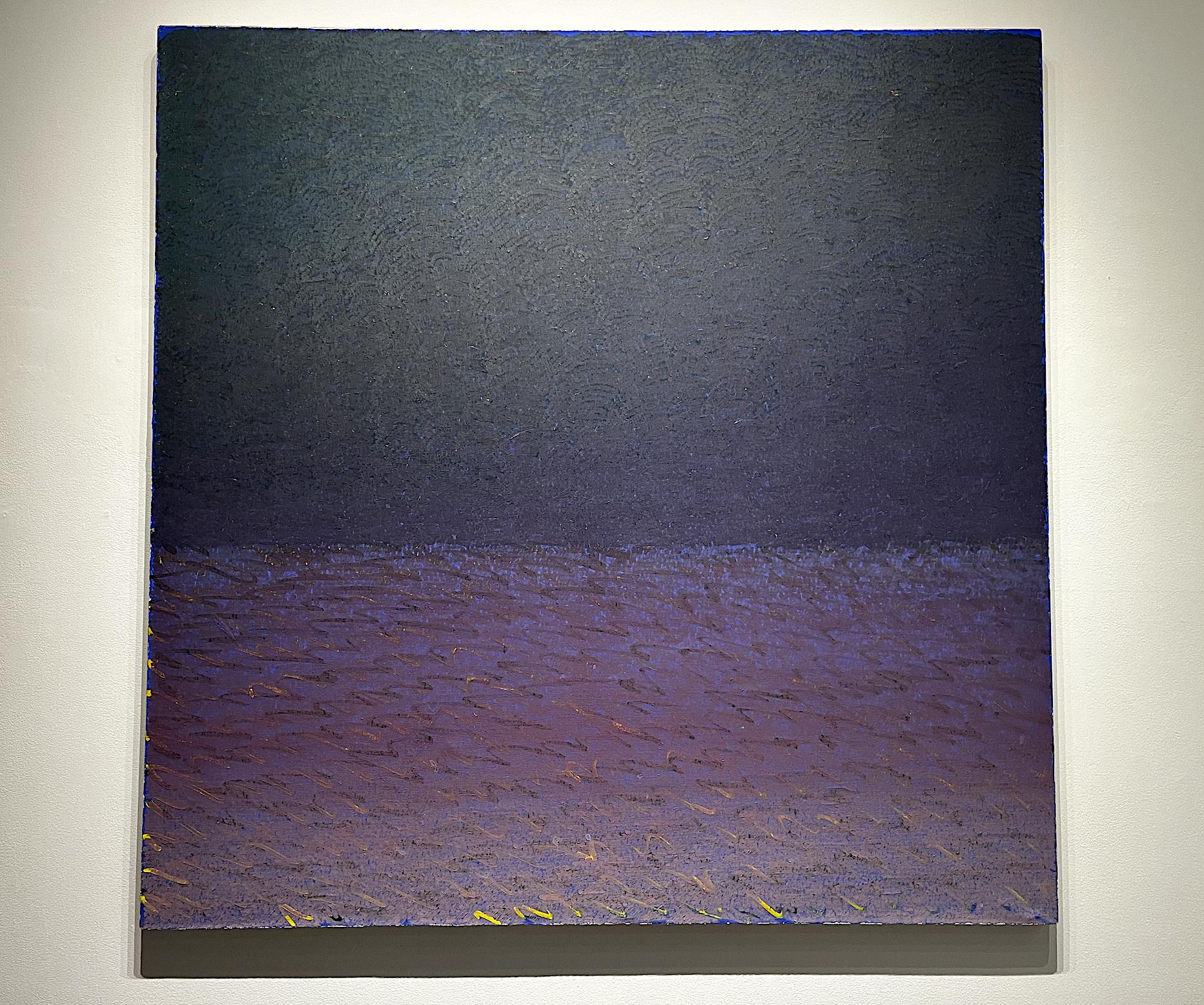Warren Rohrer: Return to Land
Locks Gallery
600 S Washington Square
Philadelphia
Nov. 5, 2024
What do you see when you look at the painting above? At first glance, I saw a tedious ocean of scribbles.
Then I saw what looked like a doomed future — a dark sky setting over a sea of light. Next I noticed yellow, peach, purple, maroon. Orange, navy, green, cobalt. The longer I looked, the more layers I saw. Brush stroke after brush stroke, a picture was building from pointillism.
It’s easy to stare forever into the eyes of Warren Rohrer’s abstract artworks, several of which are currently on display at Locks Gallery in Philadelphia and the Demuth Museum in Lancaster, Rohrer’s hometown. I almost lost myself this week while walking through Locks’ exhibit, Warren Rohrer: Return to Land.
On its surface, the image at this article’s start may look like a shitty seaside view as depicted by a depressed 4-year-old. But its depths are enough to pull you under. It’s up to us, the viewers, to stop ourselves from drowning in the painting’s wake.
The late Warren Rohrer was one of Pennsylvania’s leading artists in the mid 20th century, renowned for his minimalist approach to illustrating landscape. His ability to generate luminosity by coating canvases in sheaths of muted hues was informed by his rural Mennonite upbringing: “The processes of plowing, planting, cultivating, and harvesting are very similar to my processes of layering, defining, obscuring. [...] I’m fueled by the 'beat' of the paint application which is almost like a sowing or chopping rhythm. It’s a kind of primitive language about the nature of things,” the artist was quoted as saying in 1975.
His unique technique arrives with a loaded lesson: The message lies in the land. Rohrer looked hard at the earth around him — not to tend to it like his family of farmers, but to figure out how to translate its truth into art.
Placed in the context of 2024, I’m not sure what to make of Rohrer’s moody ocean. The gallery didn’t mention the year the work was made or the name of the piece. I’m not sure this information even exists.
If I did the research, maybe I could bullshit an article arguing that the painting is a commentary on the climate apocalypse, a depiction of an angry sky failing to reflect the abundant light of the ocean, all in all predicting the fall of mankind by muddling a 1980s color scheme into messy water.
That article would not only be speculation. It would be a projection. It’s a description of what I, the writer, see between the lines of Rorhrer’s rorschach’ed paintbrush.
Even if the land holds the truth, abstract art reminds us that the truth is always up for interpretation: First by the artist, then by the viewer. That’s a scary reality to face right now, when the truth is distorted by news outlets, social media, mental illness, and a million other mediums.
Many of us dream of living the life that Rohrer left behind. It only makes sense that the more time we spend raking through disinformation on the internet, the more desirable the distant idea of focusing only on farming the land beneath your feet becomes. It is, for many, an alternative reality ripe for romanticization.
But the truth underlying that “ignorance is bliss” fetish is that life is getting rougher for anyone who works with their hands — farmers, dishwashers, and starving artists alike. As a society, we are fortunate to have more information than ever before at our fingertips — we’re just not equipped to comb through the excess.
To translate Rohrer’s “return to the land” into the 21st century terms, I’d put it this way: The land may be dying, but there is still life to be lived under all the ink. The message lies in ourselves; rather than revert to ignorance, we have to find fresh ways to tend to the truth. Instead of getting conspiratorial, searching for false answers through cryptic pointillism or self-solipsism, we must go through the hard work of layering, defining and obscuring our person and peoples in order to harvest a root reality.
It might be too late for that seventies-style thinking to make a global mark. But in the meantime, when the air is too polluted to see, there is clarity in Rohrer’s oceanic reflections.
Look again at the sky in Roher’s painting. Radiating off the horizon are patterns resembling dirty thumbprints. In a world ruled by artificiality, humanity is what’s left in the tracks.

Warren Rohrer: Return to Land remains on display at Locks Gallery through Nov. 30. The show coincides with the exhibition Warren Rohrer: Place On Paper, which is on view at the Demuth Museum in Lancaster, Pennsylvania, through January 5 of next year.





